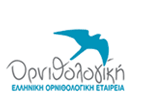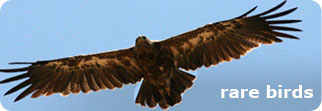Pygmy Cormorant (Phalacrocorax pygmeus) is one of the 36 species belonging to Phalacoracidae family. It is the smallest species of the family, 45-55 cm long with a wingspan of 80-90 cm. Its body is black and its head is brown. It has a long tail and a small head and bill.
It lives in wetlands with still or slowly flowing fresh water and more rarely, at winter, in coastal wetlands. It breeds in colonies on reedbeds or dense trees, alone or along with herons, Cormorants, Spoonbils, etc. It feeds on small fish and rarely on small aquatic mammals and molluscs, caught with dives.
It lays 3-6 eggs in spring and both parents incubate them alternatively for 27-30 days. Nestlings become independent after 70 days.
The species is listed as endangered according to the Greek Red Book, it is included in Appendix I of 79/409/EEC Directive for the protection of birds and their habitats, and it is also stated as a Globally Almost Endangered species.
Former distribution of Pygmy Cormorant included the region from Algeria to the Aral, but today Pygmy Cormorants are confined to the eastern coasts of the Adriatic, the northern Aegean, the Black Sea eastwards to Caspian Sea and Iraq. Countries, in which the species breeds are Albania, Greece, Bulgaria, Turkey, Romania, Moldavia, Ukraine, Russia, Azerbaijan, and Iraq, while few pairs breed in Hungary and Slovakia.
The breeding population of the species in Europe is estimated at 6,400 to 7,300 pairs, while the biggest colony is located in Danube Delta, numbering 4,000 pairs.
The Balkan populations are wintering at NE coasts of Mediterranean, mainly at N Aegean and SE coasts of Adriatic as well as at the inland lakes of the region. Ringed birds from the Danube have been recovered in Nestos Delta and former Yugoslavia. The Black Sea populations are possibly wintering at Turkey, while the Caspian population is moving further south at winter.
Greece is the only EU member where Pygmy Cormorants breed. The most important colonies are located in Lake Mikri Prespa and Lake Kerkini, while a smaller population exists in Lake Petron. The species also used to breed in Axios Delta, Lake Ismarida and Lake Kastoria, Evros Delta and Porto Lagos, but it doesn’t do it any more. The most important wintering areas in Greece are mainly the large wetlands of Thrace and Macedonia.
The most significant reasons for the decline of Pygmy Cormorant in the last few years are drainage and serious degradation of wetlands, pollution of fresh water, disturbance and destruction of riparian woodland, as well as illegal hunting and drowning of many Pygmy Cormorants in nets.
Our knowledge about Pygmy Cormorant in Greece so far derives from special research conducted in Lake Kerkini and from the midwinter counts of waterbirds.
In 1997, a triennial LIFE program for the Protection of the species in Greece was launched, by WWF, HOS and the Society for the Protection of Prespes in 10 wetlands of Macedonia and Thrace. Already, from the first results, it was found that Greece is a very important area for the species.
During the winter of 1997 great numbers were counted, proving that the greatest part of the global population winters in Greece. The breeding population of the species in our country seems to be more than 600 pairs.
It is obvious that Greece should take protection measures and special actions, if we consider its importance for the species. The main actions that should be done for the conservation of Pygmy Cormorant’s populations in Greece and the rest of the countries are the protection of wetlands, the continuous monitoring of their quality, the public’s information for its importance and value and initiation of specific management measures for the improvement of breeding and feeding areas of the species. Moreover, a further research for the species in the rest of the countries where it lives would help to comprehend the ecology and its populations, considering that our knowledge so far is limited.



